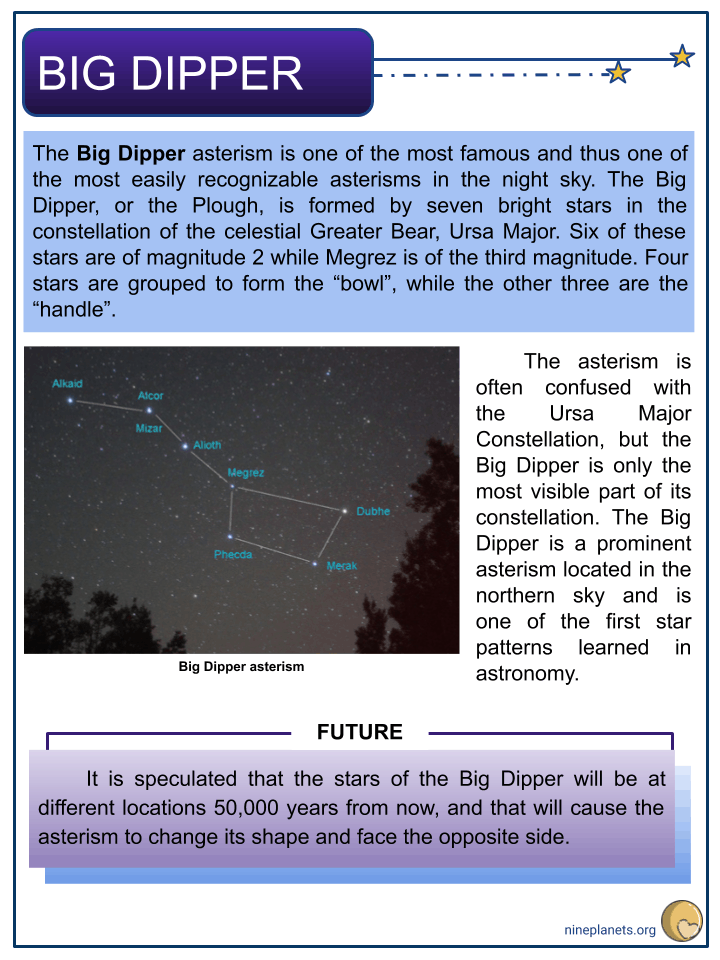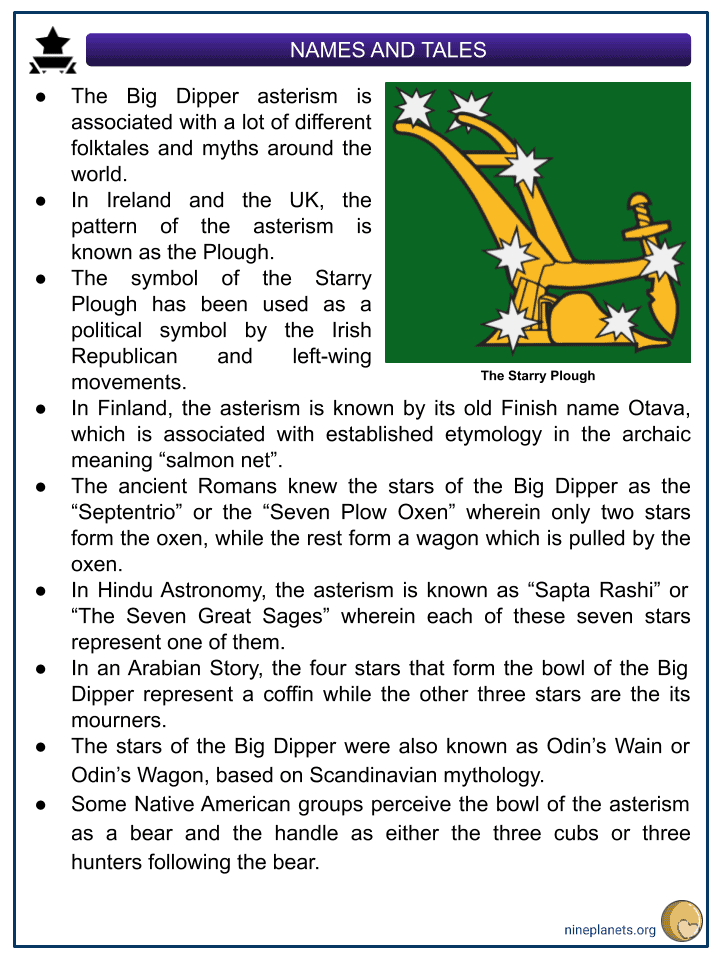Download Big Dipper Worksheets
Click the button below to get instant access to these premium worksheets for use in the classroom or at a home.

This worksheet can be edited by Premium members using the free Google Slides online software. Click the Edit button above to get started.
Download free sample
Not ready to purchase a subscription yet? Click here to download a FREE sample of this worksheet pack.
Resource Examples
Click any of the example images below to view a larger version.




Key Facts & Information
- The Big Dipper asterism is one of the most famous and thus one of the most easily recognizable asterisms in the night sky. The Big Dipper, or the Plough, is formed by seven bright stars in the constellation of the celestial Greater Bear, Ursa Major. Six of these stars are of magnitude 2 while Megrez is of the third magnitude. Four stars are grouped to form the “bowl”, while the other three are the “handle”.
- The asterism is often confused with the Ursa Major Constellation, but the Big Dipper is only the most visible part of its constellation. The Big Dipper is a prominent asterism located in the northern sky and is one of the first star patterns learned in astronomy.
Future
- It is speculated that the stars of the Big Dipper will be at different locations 50,000 years from now, and that will cause the asterism to change its shape and face the opposite side.
Names And Tales
- The Big Dipper asterism is associated with a lot of different folktales and myths around the world.
- In Ireland and the UK, the pattern of the asterism is known as the Plough.
- The symbol of the Starry Plough has been used as a political symbol by the Irish Republican and left-wing movements.
- In Finland, the asterism is known by its old Finish name Otava, which is associated with established etymology in the archaic meaning “salmon net”.
- The ancient Romans knew the stars of the Big Dipper as the “Septentrio” or the “Seven Plow Oxen” wherein only two stars form the oxen, while the rest form a wagon which is pulled by the oxen.
- In Hindu Astronomy, the asterism is known as “Sapta Rashi” or “The Seven Great Sages” wherein each of these seven stars represent one of them.
- In an Arabian Story, the four stars that form the bowl of the Big Dipper represent a coffin while the other three stars are the its mourners.
- The stars of the Big Dipper were also known as Odin’s Wain or Odin’s Wagon, based on Scandinavian mythology.
- Some Native American groups perceive the bowl of the asterism as a bear and the handle as either the three cubs or three hunters following the bear.
- In China and Japan, they are also known as the “Seven Stars of the Northern Dipper”.
- In Shinto, the seven largest stars belonged to Amenominakanushi spirits, the oldest and most powerful of all kami.
- In South Korea, the Ursa Major Constellation is referred to as the “Seven Stars of the North”, which is related to a myth.
- In Malay, the asterism is known as the “Boat Constellation”.
- In Indonesia, the stars of the Big Dipper are collectively known as the “Canoe Stars”.
- In Filipino, the Big Dipper and the Little Dipper asterisms are more often associated with the “tabo”, a one-handled water pot used in households for the purposes of personal hygiene.
Stars
- The stars of the Big Dipper have Bayer designations in consecutive Greek alphabetical order starting from the bowl to the handle.
- The five stars of the Plough, Merak, Phecda, Megrez, Alioth, and Mizar, are at the core of the Ursa Major Moving Group.
- The Ursa Major Moving Group, also known as Collinder 285 and Ursa Major Association, is a nearby stellar moving group, a set of stars with a common velocity, proper motion, and speculated to have a common origin in space and time.
- The core stars of the Ursa Major association consists of 14 stars, 13 from the Ursa Major Constellation and 1 from the Canes Venatici Constellation.
- The stream stars include a wide variety of stars from different constellations including: Aquarius, Auriga, Bootes, Camelopardalis, Canes Venatici, Cepheus, Coma Berenices, Corona Borealis, Crater, Draco, Hercules, Hydra, Leo, Leo Minor, Lepus, Lynx, Lyra, Microscopium, Ophiuchus, Orion, Pisces, Pyxis, Sagittarius, Sculptor, Serpens, Sextans, Taurus, Triangulum Australe, Ursa Major, and Virgo.
- ALIOTH
- Alioth, designated as Epsilon Ursae Majoris, is the brightest star in the Big Dipper and in the Ursa Major Constellation.
- It is the third star of the handle of the Plough.
- Alioth is a blue-white giant star with a peculiar spectrum that has calcium K-lines in it, A1III-IVp kB9.
- The star shares the 31st place as the brightest star in the night sky with one of the stars in Orion’s Belt, Alnitak.
- It has an apparent magnitude of 1.77 and an absolute magnitude of -0.2.
- Alioth is also classified as a Canum Venaticorum variable star wherein it varies in brightness due to its magnetic field and chemical peculiarity.
- Its magnetic field is about 100 times greater than the Earth’s.
- It is 2.92 times more massive than our Sun and has a solar radii of 4.14.
- Alioth is located at around 82.6 light-years away from us and has 102 solar luminosities.
- The star has a rotational velocity of 33 km and has surface temperatures of 9,020 K.
- Its traditional name Alioth has an Arabic origin which means “the sheep’s fat tail”.
- Aliothe was known as Añgiras to the Hindus, which is one of the Seven Rishis.
- In Chinese, the star is known as the Fifth Star of the Northern Dipper and the Star of Jade-Sighting Tube.
- DUBHE
- Dubhe, designated as Alpha Ursae Majoris, is the second-brightest star in the constellation of Ursa Major located around 123 light-years away from us.
- Alpha Ursae Majoris has an apparent magnitude of 1.79 and an estimated absolute magnitude of -1.10.
- It shares the 33rd place as the brightest star in the night sky with Mirfak, the brightest star in the Perseus Constellation.
- Dubhe is an orange giant star of spectral type K1 II-III.
- It is a spectroscopic binary star, with a yellow-white main- sequence star companion of spectral class F0V.
- The binary stars are 23 AU apart and orbit each other for 44.4 years.
- The primary star, Dubhe A has a mass of 4.25 solar masses, while Dubhe B weighs around 1.6 solar masses.
- Only a little information is known about the secondary star.
- Alpha Ursae Majoris A is 316 times more luminous than our Sun and has surface temperatures of 4,660 K.
- Dubhe A is a slow spinner with an estimated rotational velocity of around 2.6 km.
- Its traditional name Dubhe originates from the Arabic “bear”, which came from the phrase “the back of the Greater Bear”.
- It is also known as Ak from the Arabic origin, which means “the Eye”.
- The Hindus call the stars Kratu, which is also one of the Seven Rishis.
- In Chinese, Dubhe is known as the First Star of the Northern Dipper and the Star of Celestial Pivot.
- MERAK
- Merak, designated as Beta Ursae Majoris, is the fifth- brightest star in the Ursa Major Constellation located around 79.7 light-years away from us.
- It is a bluish-white subgiant star that has already exhausted its hydrogen supplies and began cooling down.
- Merak is a suspected variable star of spectral type A1IVps.
- Beta Ursae Majoris has a mass
- of 2.7 solar masses and an
- estimated radius of 3.02 solar radii.
- It has an apparent magnitude of 2.37 and an absolute magnitude of 0.61.
- It is estimated to be around 63.01 brighter than our Sun.
- Merak rotates at a velocity of 46 km and has estimated surfaces temperatures of 9,377 K.
- Beta Ursae Majoris is considered to be a mild Am star, which has chemical peculiarity with unusual strong lines of metallic elements.
- Its traditional name, Merak, has an Arabic origin, which means the loins.
- It is known as Pulaha to the Hindus, which is also one of the Seven Rishis.
- In Chinese, it is known as the Second Star of the Northern Dipper and Star of Celestial Roading Jade.
- PHECDA
- It is a bluish-white subgiant star that has already exhausted its hydrogen supplies and began cooling down.
- Merak is Phecda, designated as Gamma Ursae Majoris, is the sixth- brightest star in the Ursa Major Constellation located around 83.2 light-years away from us.
- Gamma Ursae Majoris is a white main-sequence dwarf star of spectral type A0Ve.
- It has an apparent magnitude of 2.438 and an absolute magnitude of 0.4.
- Phecda is considered as an Ae star, in which it is surrounded by an envelope of gas that adds emission lines to its spectrum.
- It has a companion star of spectral type K2 V and orbits each other for about 20.5 years.
- The primary star, Phecda A, is of 2.94 solar masses and has an estimated radius of 3.04 solar radii.
- It is 65.255 times more brighter than the Sun and is speculated to be around 300 million years old.
- The primary star is a fast spinner with a rotational velocity if 178 km and has surface temperatures of 9,355 K.
- The companion star, Phecda B, is 79% more massive than our Sun and is 39.7% brighter.
- Gamma Ursae Majoris B has surface temperatures of 4,780 K
- Its traditional Phecda, or Phad, originated in Arabic, which means “thigh of the bear”.
- Phecda is known as Pulastya to the Hindus, which is also one of the Seven Rishis.
- In Chinese, the star is known as the Third Star of the Northern Dipper and Star of Celestial Shining Pearl.
- MEGREZ
- Megrez, designated as Delta Ursae Majoris, is the dimmest among the stars of the Big Dipper asterism and the 11th brightest star of the Ursa Major Constellation.
- It has an apparent magnitude of 3.312 and an absolute magnitude of 1.39.
- The star is a main-sequence star of spectral type A3 V and is located around 80.5 light-years away from us.
- Megrez has excess emission of infrared radiation, which indicates the presence of circumstellar matter.
- It has a mass of 1.63 solar masses and a radius of 1.4 solar radii.
- Megrez is estimated to have surface temperatures of around 9,480 K and is 14 times brighter than our Sun.
- Megrez is also a fast spinner with a rotational velocity of 233 km.
- Its traditional name, Megrez, and historical name, Kaffa, has Arabic origins which mean “The base of the bear’s tail”.
- The Hindus knew the star as Atri, also one of the Seven Rishis.
- In Chinese, Megrez is known as the Fourth Star of the Northern Dipper and Star of Celestial Balance.
- MIZAR
- Mizar, also designated as Zeta Ursae Majoris, is the fourth-brightest star in the Ursa Major Constellation located around 82.9 light-years away from us.
- It has an apparent magnitude of 2.04 and an estimated absolute magnitude of 0.32.
- Mizar is the first telescopic binary star discovered in 1908.
- The primary star, Mizar Aa, is of spectral type A2Vp.
- Mizar Aa is estimated to be 2.222 times more massive than our Sun, while Mizar Ab is 2.238 times.
- Both have estimated radii of 2.4 times than the Sun, luminosity of 33.3 times brighter than our Sun, and temperatures of 9,000 K.
- The binary stars orbit each other for 20.5386 days.
- The components of Mizar A are both Ap stars, which has chemical peculiarity, and an abundance of strontium and silicon, due to stratification of some heavy elements in the photosphere
- of slow-rotating stars.
- Mizar B is a single-lined spectroscopic binary with visible spectrum of an Am star that has unusual strong lines of some metals.
- Mizar B is of spectral type kA1h(eA)mA7IV-V.
- The binary stars of Mizar B orbit each other for 175.55 days.
- Mizar also forms a naked-eye double with Alcor, a fainter binary star about 12 arcminutes away.
- The name Mizar derives from the Arabic meaning apron, wrapper, covering or cover.
- In the traditional Indian astronomy, Mizar is known as Vashistha, which is one of the Saptarishi.
- Chinese Taoism personifies Mizar as the Lu star.
- In Chinese, it is also known as the Sixth Star of the Northern Dipper and Star of The Opener of Heat.
- ALKAID
- Alkaid, designated as Eta Ursae Majoris, is the third- brightest star of Ursa Major and shares the 38th brightest star in the night sky with Sargas of Scorpius.
- It is of spectral type B3 V and is located around 103.9 light-years away from us.
- Alkaid is estimated to be 6.1 times more massive than the Sun and has 3.4 solar radii.
- The star is about 594 time brighter than the Sun with an apparent magnitude of 1.86 and an absolute magnitude of -0.67.
- Its traditional names, Alkaid and Benetnasch derives from the Arabic phrase meaning “The leader of the daughters of the bier”.
- The Hindus knew it Marīci, one of the Seven Rishis.
- In Japan and Korea, it is known as the military breaking star or most corner star, due to China’s influence.
- In Chinese, Alkaid is known as the Seventh Star of the Northern Dipper and the Star of Twinking Brilliance.
Big Dipper Guide To Other Stars
- Merak and Dubhe are known as the Pointer Stars used to find the North Pole star, which is currently Polaris.
- The arc of Big Dipper’s handle points to Arcturus of the Bootes Constellation and a little further is Spica of the Virgo Constellation.
- Megrez and Phecda point to Regulus, the brightest star of Leo, and Alphard, the brightest star of Hydra.